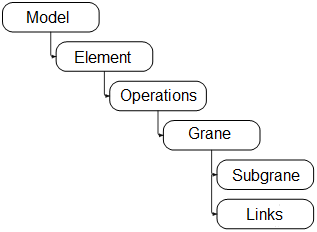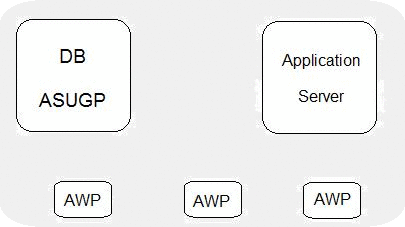То choose time is to save time
Grynevych Iryna
Faculty of computer science and technology (CST)
Department of computer engineering (CE)
Speciality System programming
Scientific adviser: Candidate of Technological Science Zeleneva Irina
Introduction
Automated systems are used everywhere nowadays. State enterprise Ukrzaliznitsya
is not exception. This enterprise uses its own software for the most difficult processes realization. Software contains many parts where are important providing automated workplaces and application servers with all the necessary data. This providing is the thing what software used for. To reduce the operators routine work increasing of automated workplaces is needed, that's why there is a need to develop a specialized system [1].
Actuality
The State Enterprise Ukrzaliznitsya
has at its disposal sophisticated automated system of fright management (ASUGP), which runs under DBMS Oracle. Data on the work of railway facilities is written into certain models of a particular type of object.
However, there is a problem with transforming objects into object form, where they can be stored into files or databases and can be easily recovered. The solution is writing of object-relative system, which contains either relative or object system properties.
Construction of an information system for simple domain monitoring (homogeneous objects of observation, small fixed number of independent parameters) is not difficult — you may just use any standard RDBMS. It is more difficult if you want to record the results of observations of many different types of objects that are held by multiple independent users and store data for later analysis [2].
Object-relational reflection
With object-relational approach you may formet about SQl and think objectively, but at the same time you should use the achievements of relational databases, by implementing the display of objects and tables [3].
The system of reflected models management is a specialized software for object-relational mapping databases.
Object-relational mapping (Object-relational English mappipg — ORM) is programming technology that links databases to the concepts of object-oriented programming languages by creating a virtual object database
". There are both commercial and free implementations of this technology [4].
In an object-relational databases, information is organized in a familiar relational tabular structures. Object-relational (OR) researches suggest support for the implementation of the relational data model. OR DBMSs are sequentional development of earlier DBMSs. Unlike pure object databases, the transition to object-relational systems do not require massive reprogramming [5].
Aims and tasks, expected results
The aim of master's work is to develop ORM-system, which allows reilway data and its parts storing in special models. The presence of different model containers is assumed.
Appointment of model container is ASUGP-models representation, which implements the functionality of placing data in memory, data exchange with external software code, saving the data on your hard drive and its restoring.
The moodel container allows you to save a any number of operational model, so at runtime it interacts with components that implement the representation of models of memory (the library model derived class-specific models ASUGP).
The model container is developed as a plugin that connects to a complex of control flow calls and components. Internally, the container contains collection of svom
models, with which it implements almost all of the technological functionality. It can be said that container is a wrapper for a model collection, which makes the last of the class in a simple module that connects to the complex management challenges, processes and components.
As far as model container is stored in ROM, it is possible to increase the speed of working with data in it.However, for bigger value of data servers with greater ROM are necessary.
Also there should be used object-oriented principles, which reduce the amount of code and create some basic structure and function facilities.
The model container must implement such functions as creating and filling the collection of standard models, conservation and loading data from files of standard models, software updating of model collection.
Review of analogues
There are three ORM-analogues that can be observed: ADO.NET Entity Framework, NHibernate and DataObjects.NET.
ADO.NET Entity Framework
ADO.NET Entity Framework enables developers to create applications that work with the conceptual data model, rather than directly from the relational schema to store them. The aim is to reduce code size and reducing the cost of maintenance of applications, which are data-oriented [6]
NHibernate
NHibernate &mdash ORM-platform solution for Microsoft. NET, ported to Java. This is a free open source library, which is licensed under the GNU Lesser General Public License.
NHibernate allows you to display objects from the business logic to the relational database. For a given XML-description of entities and relationships NHibernate automatically generates SQL-queries for loading and saving of objects [7].
DataObjects.NET
DataObjects.NET — a library that provides common storage of .NET-objects in a relational database.
Using DataObjects.NET makes all data automatically compatible with Microsoft SQL Server, MDSE 2000, Microsoft Access, Oracle, Firebird, MaxDB, without any additional code [8].
The basic structure of the model used at the enterprise
For precise control of the input data sequence in an automated control system is used event model. Each model has a typed structure (Fig. 1).
The elements of svom-models for communication between each other use links that allows quick transition from one element to another.

Figure 1 — The basic structure of the model used at the enterprise
The structure of system of reflected models management
One of the functions of the complex is to provide data transfering to ASUGP automated workplaces. Thus, if each workplace will request information directly from the database, it will increase the load on the network and the database itself. In case of enhanced functionality and working with models, the process of obtaining statistical data can lead to congestion of ASUGP, and hence to an increase in duration of responsing (latency) complex. Consequently, the main objectives are unloading the ASUGP complex, reducing network traffic and maintenance of workplaces.
In order to relieve the automated control system there must be developed special server applications that receive the information, carry out its mapping and service automated workplaces (Fig. 2). Application server must be able to scale svom performance, which means that application server can receive data from another, thus reducing the load on the database ASUGP.

Figure 2 — The generic structure of the system of reflected models management (Animation: 7 shots, delay between shots equals 2 seconds, infinite looping, size 405*227, 144 KB)
The structure of typed models in complex ASUGP is completely generated by specialized tools. The system of reflected models management copies this structure in the main, with some unused fields or tables may be absent in order to reduce memory usage on application servers, and workstations.
Conclusion
it is assumed that developped spesialized system of reflected models management will satisfy all the conditions and let users get all needed data. At the moment the project is in a completion stage and the correlation with previous developments for preserving data.
